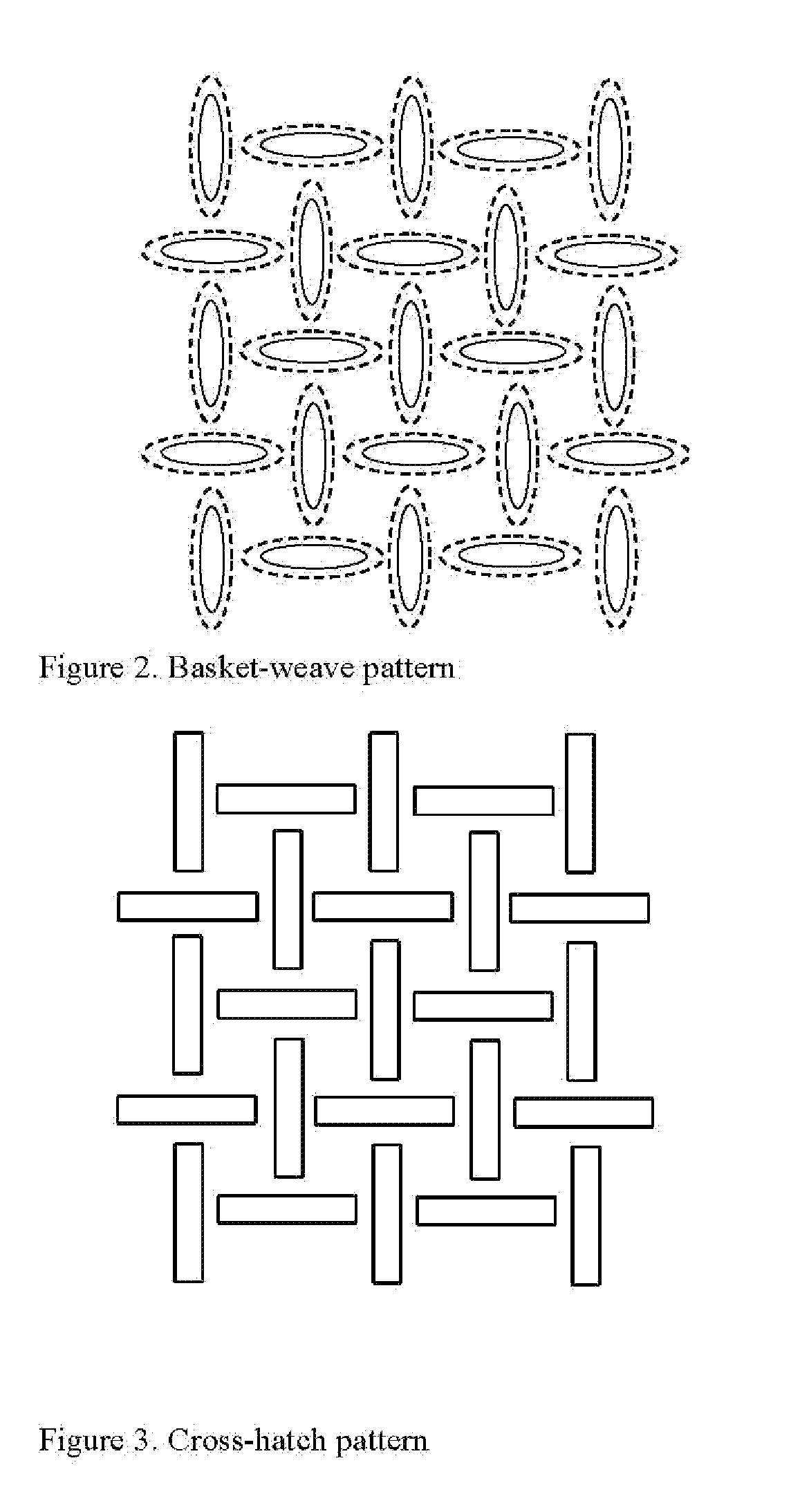Nonwoven bonding patterns producing fabrics with improved abrasion resistance and softness
a nonwoven, bonding pattern technology, applied in the field of nonwoven fabrics, can solve the problems of poor abrasion resistance of pe/pet sheath/core, loss of softness and drapeability of bicomponent spunbond, etc., to achieve the effect of high abrasion resistance and strength, and loss of softness
- Summary
- Abstract
- Description
- Claims
- Application Information
AI Technical Summary
Benefits of technology
Problems solved by technology
Method used
Image
Examples
example 1
[0041]A nonwoven base material was produced using 40 / 60 PE / PET sheath / core bicomponent spunbond fibers through pressure bonding with cold calender rolls at room temperature at a nip pressure of 400 pli. The base material has a basis weight of 40 gsm.
[0042]For the test samples, the base material was thermally point bonded using basket-weave pattern with 30% bond area or using a diamond pattern with 40% bond area. Both bonding experiments were conducted at various calender temperatures (239-266° F. of both top and bottom rolls), and speeds (10-200 ft / min), and range of nip pressures (75-1500 pli).
[0043]The thermal point bonding was performed using an embossed roll and a smooth roll in a single pass. Both the test samples and control samples have a basis weight of 40 gsm.
[0044]The test data are summarized in Table 1.
TABLE 1ResultAdditional Treatment StepBondTemp.PressureAbrasionMaterialTop RollBottom RollArea (%)(° F.)(pli)ResistanceSoftnessTest BW1SmoothB-W302523500.839.3Test Dia1Smoo...
example 2
[0047]A nonwoven base material was produced using 40 / 60 PE / PET sheath / core bicomponent spunbond fibers through thermal bonding on a calender roll with an oval pattern with 18% bonding area at 265° F. and at a nip pressure of 600 pli. The base material has a basis weight of 40 gsm.
[0048]For the test samples, the base material was thermally point bonded using basket-weave pattern with 30% bond area. The bonding was conducted at various calender temperatures (239-266° F. of both top and bottom rolls), and a fixed speed of 10 ft / min and a nip pressure of 750 pli.
[0049]The thermal point bonding was performed using an embossed roll and a smooth roll in a double pass for the test sample.
[0050]The control sample was prepared in a single pass under the conditions specified in Example 1. Both the test and the control samples have a basis weight of 35 gsm.
[0051]The test data are summarized in Table 2.
TABLE 2ResultAdditional Treatment StepBondTemp.PressureAbrasionMaterialTop RollBottom RollArea...
example 3
[0054]A nonwoven base material was produced using 40 / 60 PE / PET sheath / core bicomponent spunbond fibers through thermal bonding on a calender roll with an oval pattern with 18% bonding area at 265° F. and at a nip pressure of 600 pli. The base material has a basis weight of 40 gsm.
[0055]For the test samples, the base material was thermally point bonded using basket-weave pattern with 30% bond area. The bonding was conducted at a fixed temperature 276° F., at a fixed speed of 200 ft / min and at a nip pressure of 750 pli.
[0056]The thermal point bonding was performed using an embossed roll and a smooth roll in a double pass for the test sample.
[0057]The control sample was prepared in a single pass under the same conditions as the test material except that a single pass is used. Both the test samples and control samples have a basis weight of 40 gsm.
[0058]The test data are summarized in Table 3.
TABLE 3ResultAdditional Treatment StepBondTemp.PressureAbrasionMaterialTop RollBottom RollArea ...
PUM
| Property | Measurement | Unit |
|---|---|---|
| Fraction | aaaaa | aaaaa |
| Fraction | aaaaa | aaaaa |
| Fraction | aaaaa | aaaaa |
Abstract
Description
Claims
Application Information
 Login to View More
Login to View More - R&D
- Intellectual Property
- Life Sciences
- Materials
- Tech Scout
- Unparalleled Data Quality
- Higher Quality Content
- 60% Fewer Hallucinations
Browse by: Latest US Patents, China's latest patents, Technical Efficacy Thesaurus, Application Domain, Technology Topic, Popular Technical Reports.
© 2025 PatSnap. All rights reserved.Legal|Privacy policy|Modern Slavery Act Transparency Statement|Sitemap|About US| Contact US: help@patsnap.com



